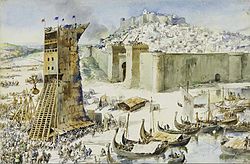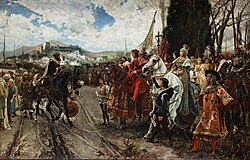The Reconquista (literally meaning ‘re-conquest’) was a period of nearly eight centuries of Iberian history during which the Christians who had managed to survive the Muslim conquest of the peninsula by clinging to lands in the far north gradually reconquered the country from the Islamic powers. This was a very gradual process. It began in the second half of the eighth century and progressed gradually at first, accelerating at distinct intervals, with a major push in the eleventh, twelfth and thirteenth centuries by emerging Christians such as Portugal, Castile and Aragon. Yet at times the Moors or Moriscos of the south fought back as they acquired military aid from North Africa around Morocco and Algeria. Owing to this to-and-fro it was not until 1492 that the Reconquista was completed when the joint-rulers of Castile and Aragon, Queen Isabella and King Ferdinand, conquered the southern emirate. The reconquest was accompanied by waves of migration over the centuries as Christians from the north settled in newly conquered lands and the Muslims of the south left Iberia altogether for North Africa and other Islamic countries.[1]
Research your ancestors on MyHeritage
The Reconquista chronology of eventsThe Reconquista chronology of events
In the year 711, after completing their rapid conquests of the Middle East and North Africa, the first Muslim armies crossed the Straits of Gibraltar and invaded the Visigothic Kingdom of Spain. Like all other powers before it, the Visigoths quickly succumbed to the Muslim advance and within just a few years virtually all of the Iberian Peninsula was conquered. Yet thereafter the Muslim advanced finally stalled as their armies tried to penetrate into France, being checked by the forces of Charles Martel at the Battle of Tours in 732. The Muslims subsequently retreated back into Iberia and consolidated their position in that country. Within years it became apparent that they could not fully hold the north of the country and the Christian Kingdom of Asturias emerged in the far north and north-west. It would form the kernel from which the Christian Reconquista or reconquest of the peninsula would begin even as the Umayyad Caliphate of Cordoba emerged as an independent Islamic state under Abd al-Rahman in the middle of the eighth century.[2]

The Reconquista was undertaken gradually over the next eight centuries by a number of Christian kingdoms and principalities which emerged over time including the kingdoms of Asturias, Leon, Castile, Aragon and the counties of Barcelona and Portugal. The border between these and the Moorish states to the south, of which the emirates of Cordoba and Granada were the foremost at various time, was relatively static for some periods and then shifted rapidly during eras of aggressive Christian expansion. For instance, the west of the peninsula experienced a period of extensive reconquest in the century between the 1140s and the 1240s, as the County of Portugal expanded into the Kingdom of Portugal, Lisbon was conquered in 1147 as part of the Second Crusade and the Algarve was then invaded, culminating in the seizure of the southern city of Faro in 1249.[3]
By the fifteenth century three major Christian powers had reclaimed nearly all the peninsula, the kingdoms of Portugal, Castile and Aragon. The latter two would eventually unite to become the Kingdom of Spain. That union eventually came about owing to the marriage of Queen Isabella and King Ferdinand. These same two monarchs completed the Reconquista in 1492 as their forces conquered Granada in the south of the country. As the Reconquista progressed it led to waves of migration as Christians from the north and from southern France migrated towards newly reclaimed lands and as Muslims from southern Spain left Iberia altogether and headed for North Africa.[4]
Extent of migration during and after the ReconquistaExtent of migration during and after the Reconquista
As much of the migration associated with the Reconquista occurred in the early medieval period and the High Middle Ages (1000–1300) it is difficult to establish the extent of it with any certainty owing to a lack of precise statistical and demographic records. Returning to the example of the siege and capture of Lisbon in 1147 as part of the early stages of the Second Crusade, we know that many of the crusaders from France, England, Germany and other regions elected to remain in Lisbon after the city was captured instead of proceeding onwards to the Holy Land. Afonso I of Portugal also sought to Christianize the city as much as possible thereafter, expelling many Muslims and bringing in Christians from northern Portugal and elsewhere in Iberia. Therefore the city was effectively colonized by Christians from around Western Europe, while the former Muslim inhabitants either fled south to the Muslim-held parts of the peninsula or to North Africa, though some simply moved to the outskirts of Lisbon where they were allowed to live outside the city walls. Unfortunately, though, while we have a general idea of these movements, we do not have any statistical data with which to establish the extent of all this migration with any precision.[5]

This is less true of the period encompassing the end of the Reconquista and the century or so that followed as waves of expulsions of Moors or Moriscos were initiated by successive Spanish governments. Between the end of the Reconquista in the 1490s and a final wave of expulsions in the 1610s it is believed over two and a half million Muslims were driven from the peninsula, with most resettling in North Africa or the territory of the Ottoman Empire in the eastern Mediterranean. Some of this was carried out under the auspices of the Spanish Inquisition. One major wave of emigration occurred in the mid-1490s in the immediate aftermath of the fall of Granada.[6] Thereafter a steady flow of emigrants from Spain was maintained throughout the sixteenth century before a final massive wave between 1609 and 1614 as King Philip III issued an expulsion decree which effectively ended religious toleration of any kind for remaining Muslims. This latter expulsion resulted in the departure of between 300,000 and half a million Moriscos from Spain.[7]
Demographic impact of the ReconquistaDemographic impact of the Reconquista
The Reconquista involved a complete transformation of the religious landscape of the Iberian Peninsula. Once it was completed Spain and Portugal were established as two of the most zealously Christian states in all of Europe. Yet the demographic impact was much more complex. The Convivencia or ‘Co-existence’ between Christians, Muslims and Jews which had characterized life across the peninsula for centuries had led to significant intermarriage and relations and as a result the ethnic makeup of the Spanish and Portuguese people today has been greatly impacted on by the Berber and Arab Muslims who arrived to the peninsula from the eighth century onwards.[8] Equally, the hundreds of thousands of Muslims who left Spain and Portugal in the medieval and early modern periods and resettled in North Africa often were the descendants of Christians and Muslims who had intermarried in Iberia decades or centuries earlier. As such, while the Reconquista saw Iberia reclaimed eventually for the Christian faith, the wider process of racial intermixing which occurred over eight centuries could never be undone and the demographic landscape of Spain, Portugal and Morocco today bears the lasting imprint of the Reconquista period, while the cultural legacy of al-Andalus, the Islamic name for Iberia, remains strong over half a millennium later.[9]
See alsoSee also
Explore more about the ReconquistaExplore more about the Reconquista
- Spain, Baptisms, 1502-1940 record collection at MyHeritage
- Spanish Names: the Origins of Spanish Given Names and Surnames at the MyHeritage blog
- Matrimonio a la española: marital customs & marriage records in Spain at Legacy Family Tree Webinars
- Top 5 resources to expand your Spanish genealogical research at Legacy Family Tree Webinars
References
- ↑ https://www.worldhistory.org/Reconquista/
- ↑ https://www.worldhistory.org/Abd_al-Rahman_I/
- ↑ https://www.jstor.org/stable/41105214
- ↑ https://www.history.com/this-day-in-history/reconquest-of-spain
- ↑ https://spiritofthecamino.com/muslim-city-lisbon/
- ↑ https://www.historytoday.com/reviews/purging-muslim-spain
- ↑ https://www.manchesterhive.com/display/9781526166180/9781526166180.00011.xml
- ↑ https://www.tandfonline.com/doi/full/10.1080/09518967.2020.1741231
- ↑ https://las.illinois.edu/news/2023-06-08/professor-examines-lasting-legacy-al-andalus-arabs-muslims-today

